Researchers identify gene linked to congenital heart disease
Researchers have identified a gene that plays a minor role in congenital heart disease, using a combined approach that could aid studies of this and other multigenic diseases
2021-06-08
(Press-News.org) New insight on the link between a gene called SORBS2 and congenital heart disease has been published today in eLife, with findings that may help explain the cause of the disease in some patients.
Some people with congenital heart disease are missing part of the long arm of chromosome 4, otherwise known as chromosome 4q. Chromosomes are thread-like structures made up of DNA. When part of the chromosome is missing, it means that some of the genes located on that section are also lost. Previous studies have linked heart defects related to chromosome 4q deletion syndrome to a missing copy of the HAND2 gene that is found in chromosome 4 and is important for heart development. But not every patient with a heart defect is missing HAND2, which suggests other genes are likely involved as well.
"A previous study of one patient with congenital heart disease suggested mutations in a gene called SORBS2 might be responsible, but this finding had yet to be confirmed," explains first author Fei Liang, a physician at the Neonatal Intensive Care Unit, Shanghai Children's Medical Center, China.
To explore the potential role of SORBS2 in congenital heart disease, Liang and colleagues suppressed the gene in developing human heart cells grown in the laboratory. This led to the development of abnormally shaped heart cells and interfered with the ability of cardiac muscle cells to undergo necessary changes in gene expression.
The team's additional studies in genetically engineered mice showed that a lack of SORBS2 led to the absence or duplication of the wall between the two upper chambers of the heart in 40% of embryos. This duplication is a condition known as double atrial septum. However, the effect was much milder in comparison to human heart defects, suggesting that SORBS2 may be a 'small effect size' congenital heart disease gene - that is to say, it plays a minor role in the disease.
The team further examined how a lack of SORBS2 can affect gene expression in both mice and human cells. Their results highlighted how the levels of other genes and proteins are elevated or reduced in response to the lack of SORBS2, ultimately leading to heart defects and damage.
Finally, they found that rare, damaging variants of the SORBS2 gene were significantly enriched in 300 congenital heart disease cases where gross chromosomal aberrations did not occur. This provides additional genetic evidence that SORBS2 variants have a role in causing general congenital heart disease.
"Our combined studies help explain the cause of congenital heart disease in chromosome 4q deletion syndrome patients who still have the functional HAND2 gene," concludes senior author Zhen Zhang, a professor at Shanghai Pediatric Congenital Heart Disease Institute and Pediatric Translational Medicine Institute, Shanghai Children's Medical Center. "They provide an effective approach for identifying other genes that play a minor role in congenital heart disease and other multigenic diseases. Interestingly, we found that SORBS2 deficiency can cause double atrial septum, a very rare cardiac anomaly linked to a condition called paradoxical thromboembolism. The exact causes of this anomaly are currently unknown, and we hope our study paves the way for exploring this further."
INFORMATION:
Media contact
Emily Packer, Media Relations Manager
eLife
e.packer@elifesciences.org
+44 (0)1223 855373
About eLife
eLife is a non-profit organisation created by funders and led by researchers. Our mission is to accelerate discovery by operating a platform for research communication that encourages and recognises the most responsible behaviours. We aim to publish work of the highest standards and importance in all areas of biology and medicine, including Developmental Biology, while exploring creative new ways to improve how research is assessed and published. eLife receives financial support and strategic guidance from the Howard Hughes Medical Institute, the Knut and Alice Wallenberg Foundation, the Max Planck Society and Wellcome. Learn more at https://elifesciences.org/about.
To read the latest Developmental Biology research published in eLife, visit https://elifesciences.org/subjects/developmental-biology.
Full list of funders:
Science and Technology Commission of Shanghai Municipality, Collaborative Innovation Program of Shanghai Municipal Health Commission, National Natural Science Foundation of China, Shanghai Municipal Education Commission-Gaofeng Clinical Medicine Grant Support, Shanghai Sailing Program, Innovative Research Team of High-level Local Universities in Shanghai, Science and Technology Commission of Shanghai Municipality
Full list of grant numbers:
20JC1418500, 2020CXJQ01, 81371893, 31371465, 20171925, 18YF1414800, SSMU-ZDCX20180200, 20DZ2260900, 81741031, 81871717, 81672090, 31771612
ELSE PRESS RELEASES FROM THIS DATE:
2021-06-08
Converting Central American tropical forests into agricultural land is changing the colour and composition of natural material washing into nearby rivers, making it less likely to decompose before it reaches the ocean, a new Southampton-led study has shown.
The flow of dissolved organic material, such as soil, from land to the oceans plays an important role in the global carbon and nutrient cycles. Changing how land is used can alter the type and amount of material being transported, with widespread implications for ecosystems.
In this latest study, an international research team set out to learn more about the effects of deforestation on the coastal environment by studying material that flowed into rivers from various settings in a Central American rainforest, tracking its progress into ...
2021-06-08
applying a thin sheath around the defective vein eliminated the varicose vein problem in over 95 per cent of cases. The research team published their findings in the Journal of International Medical Research on 6 April 2021.
When the blood pools in the leg
Varicose veins are more than just a cosmetic problem: the unsightly bulges might result in serious health problems such as leg ulcers, thromboses or even pulmonary embolisms. The cause of varicose vein disease is usually a weakness in the connective tissue, which causes the vein wall to give way and thus the vein diameter to grow. This process is accelerated by pregnancy or frequent standing and sitting.
The increase in vein diameter impairs the function of the vein valves. The valve leaflets are pulled apart and a leak ...
2021-06-08
Weakened electrical signals in the brain may be an early warning sign of age-related neurodegenerative diseases such as Alzheimer's disease, suggests a study published today in eLife.
The findings hint at new ways to identify early on patients who may have an age-related brain disease. They also provide new insights on the changes that occur in the brain as these diseases develop.
"As tools for detecting Alzheimer's disease early are limited, there is a need to develop a reliable, non-invasive test that would enable early diagnosis," says first author Murty Dinavahi, who was a PhD Research Scholar at the Centre for Neuroscience, Indian ...
2021-06-08
The Late Triassic Tianqiaoling flora is well-known in China, and its discovery has changed our understanding of Chinese Late Triassic phytogeographical divisions. More broadly, this flora has great significance for the study of phytogeography in East Asia during this time. However, the previous dating of this flora was only evidenced by plant fossils and stratigraphic correlation, and the accurate dating has still not been achieved. Recently, the team of Dr. Yuhui FENG of Shenyang Normal University collected isotope dating samples from the bottom of the Tianqiaoling Formation, which is conformally contacted the Tianqiaoling flora-bearing beds (Figure 1). The ...
2021-06-08
Difficulty sleeping, sleep apnea and narcolepsy are among a range of sleep disorders that thousands of Danes suffer from. Furthermore, it is estimated that sleep apnea is undiagnosed in as many as 200,000 Danes.
In a new study, researchers from the University of Copenhagen's Department of Computer Science have collaborated with the Danish Center for Sleep Medicine at the danish hospital Rigshospitalet to develop an artificial intelligence algorithm that can improve diagnoses, treatments, and our overall understanding of sleep disorders.
"The algorithm is extraordinarily precise. We completed various tests in which its performance rivaled that of the best doctors ...
2021-06-08
When sailing along on the seas and you suddenly spot a porpoise's fin in the distance, chances are that you have only encountered a single animal. Porpoises are most often seen alone, but new research now suggests that they also roam in groups - and even enter into a sophisticated collaboration when hunting.
The way they collaborate surprises us, because the common perception among biologists is that porpoises roam and hunt alone, says Associate Professor Magnus Wahlberg, who is an expert in marine mammals and heads the Marine Biological Research Centre at the University of Southern Denmark (SDU).
Drone footage has revealed group hunting among porpoises coming together to hunt schools of fish.
The research team has recorded almost 44 hours of drone footage from the waters around ...
2021-06-08
Men who suffer sensory loss, particularly hearing loss, are more likely to be physically inactive and obese than women, according to a new study published in the European Journal of Public Health.
Researchers analysed data from more than 23,000 Spanish adults, and examined associations with physical inactivity and obesity in people with vision and hearing loss, and explored differences between men and women.
Results suggest inactive people with hearing loss were 1.78 times more likely to be obese compared to those who did not have any hearing loss. In people who had difficulty seeing, the odds ratio is slightly smaller, with a likelihood ...
2021-06-08
Systematic literature review provides evidence base for new therapeutic avenues in vasculitis
Researchers have reviewed all clinical trials of targeted drugs used in the treatment of vasculitis. With this, they propose a completely mechanistic categorisation of these diseases, which may in time provide better treatment.
Diseases which cause inflammation of the blood vessels are presently categorised according to the size of the blood vessels involved. But it would make more sense - and ultimately end with better treatment - if the diseases were categorised based on the causes of the inflammation.
This is shown by a systematic literature review of clinical trials in vasculitis, which researchers from Aarhus ...
2021-06-08
Astrophysicists from the University of Bath have developed a new method for pinpointing the whereabouts of extremely rare extragalactic objects. They hope their technique for finding 'changing-look quasars' will take scientists one step closer to unravelling one of greatest mysteries of the universe - how supermassive black holes grow. Quasars are believed to be responsible for regulating the growth of supermassive black holes and their host galaxies.
A quasar is a region of spectacular luminosity at the centre of a galaxy, powered by a supermassive black hole - the largest type of black hole, with a mass that exceeds that of our sun by millions or billions. There is a supermassive black hole ...
2021-06-08
When it comes to climate change, policymakers may fail to see the trees for the forest. Turns out that the trees may be the answer after all, according to a study published by authors from more than seven countries on June 3rd in Nature Climate Change.
"Climate change and biodiversity loss are two major environmental challenges," said paper author Akira S. Mori, professor at Yokohama National University. "But the vast majority of attention has been paid to one unidirectional relationship -- climate change as a cause and biodiversity loss as a consequence."
Mori and his co-authors argue that climate change and species ...
LAST 30 PRESS RELEASES:
[Press-News.org] Researchers identify gene linked to congenital heart disease
Researchers have identified a gene that plays a minor role in congenital heart disease, using a combined approach that could aid studies of this and other multigenic diseases

